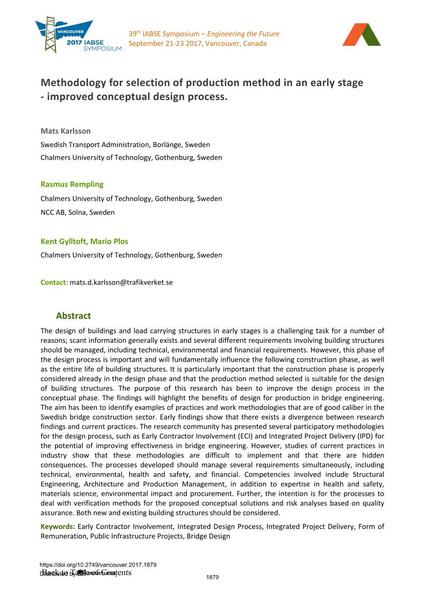Methodology for selection of production method in an early stage

|
|
|||||||||||
Détails bibliographiques
| Auteur(s): |
Mats Karlsson
(Swedish Transport Administration, Borlänge, Sweden Chalmers University of Technology, Gothenburg, Sweden)
Rasmus Rempling Kent Gylltoft (Chalmers University of Technology, Gothenburg, Sweden) Mario Plos (Chalmers University of Technology, Gothenburg, Sweden) |
||||
|---|---|---|---|---|---|
| Médium: | papier de conférence | ||||
| Langue(s): | anglais | ||||
| Conférence: | IABSE Symposium: Engineering the Future, Vancouver, Canada, 21-23 September 2017 | ||||
| Publié dans: | IABSE Symposium Vancouver 2017 | ||||
|
|||||
| Page(s): | 1879-1886 | ||||
| Nombre total de pages (du PDF): | 8 | ||||
| Année: | 2017 | ||||
| DOI: | 10.2749/vancouver.2017.1879 | ||||
| Abstrait: |
The design of buildings and load carrying structures in early stages is a challenging task for a number of reasons; scant information generally exists and several different requirements involving building structures should be managed, including technical, environmental and financial requirements. However, this phase of the design process is important and will fundamentally influence the following construction phase, as well as the entire life of building structures. It is particularly important that the construction phase is properly considered already in the design phase and that the production method selected is suitable for the design of building structures. The purpose of this research has been to improve the design process in the conceptual phase. The findings will highlight the benefits of design for production in bridge engineering. The aim has been to identify examples of practices and work methodologies that are of good caliber in the Swedish bridge construction sector. Early findings show that there exists a divergence between research findings and current practices. The research community has presented several participatory methodologies for the design process, such as Early Contractor Involvement (ECI) and Integrated Project Delivery (IPD) for the potential of improving effectiveness in bridge engineering. However, studies of current practices in industry show that these methodologies are difficult to implement and that there are hidden consequences. The processes developed should manage several requirements simultaneously, including technical, environmental, health and safety, and financial. Competencies involved include Structural Engineering, Architecture and Production Management, in addition to expertise in health and safety, materials science, environmental impact and procurement. Further, the intention is for the processes to deal with verification methods for the proposed conceptual solutions and risk analyses based on quality assurance. Both new and existing building structures should be considered. |
||||
